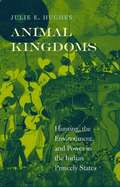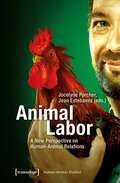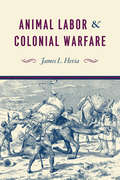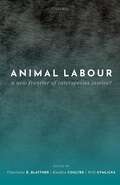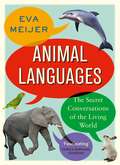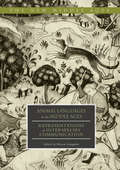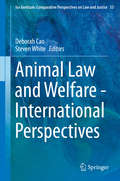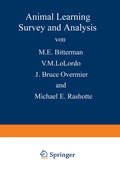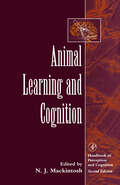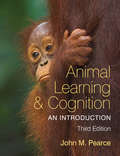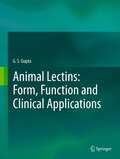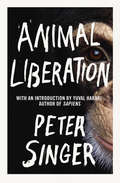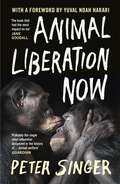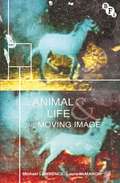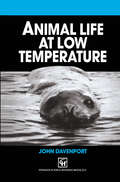- Table View
- List View
Animal Kingdoms: Hunting, The Environment, And Power In The Indian Princely States
by Julie E. HughesAnimal Kingdoms reveals the far-reaching cultural, political, and environmental importance of hunting in colonial India. Julie E. Hughes explores how Indian princes relied on their prowess as hunters of prized game to advance personal status, solidify power, and establish links with the historic battlefields and legendary deeds of their ancestors.
Animal Kingdoms: Hunting, The Environment, And Power In The Indian Princely States
by Julie E. HughesAnimal Kingdoms reveals the far-reaching cultural, political, and environmental importance of hunting in colonial India. Julie E. Hughes explores how Indian princes relied on their prowess as hunters of prized game to advance personal status, solidify power, and establish links with the historic battlefields and legendary deeds of their ancestors.
Animal Labor: A New Perspective on Human-Animal Relations (Human-Animal Studies #18)
by Jocelyne Porcher Jean EstebanezDo animals work? Is it possible to work with animals without exploiting them? Might animals even be empowered through work? This provocative collection offers original answers to these questions and allows readers to think about human relationships with domestic animals beyond the well-trodden tropes of domination or animal welfare. To study animal work means to look at animals in new ways and to discover in them unsuspected skills and knowledge that open up new ethical and political horizons.
Animal Labor and Colonial Warfare
by James L. HeviaUntil well into the twentieth century, pack animals were the primary mode of transport for supplying armies in the field. The British Indian Army was no exception. In the late nineteenth century, for example, it forcibly pressed into service thousands of camels of the Indus River basin to move supplies into and out of contested areas—a system that wreaked havoc on the delicately balanced multispecies environment of humans, animals, plants, and microbes living in this region of Northwest India. In Animal Labor and Colonial Warfare, James Hevia examines the use of camels, mules, and donkeys in colonial campaigns of conquest and pacification, starting with the Second Afghan War—during which an astonishing 50,000 to 60,000 camels perished—and ending in the early twentieth century. Hevia explains how during the nineteenth and twentieth centuries a new set of human-animal relations were created as European powers and the United States expanded their colonial possessions and attempted to put both local economies and ecologies in the service of resource extraction. The results were devastating to animals and human communities alike, disrupting centuries-old ecological and economic relationships. And those effects were lasting: Hevia shows how a number of the key issues faced by the postcolonial nation-state of Pakistan—such as shortages of clean water for agriculture, humans, and animals, and limited resources for dealing with infectious diseases—can be directly traced to decisions made in the colonial past. An innovative study of an underexplored historical moment, Animal Labor and Colonial Warfare opens up the animal studies to non-Western contexts and provides an empirically rich contribution to the emerging field of multispecies historical ecology.
Animal Labor and Colonial Warfare
by James L. HeviaUntil well into the twentieth century, pack animals were the primary mode of transport for supplying armies in the field. The British Indian Army was no exception. In the late nineteenth century, for example, it forcibly pressed into service thousands of camels of the Indus River basin to move supplies into and out of contested areas—a system that wreaked havoc on the delicately balanced multispecies environment of humans, animals, plants, and microbes living in this region of Northwest India. In Animal Labor and Colonial Warfare, James Hevia examines the use of camels, mules, and donkeys in colonial campaigns of conquest and pacification, starting with the Second Afghan War—during which an astonishing 50,000 to 60,000 camels perished—and ending in the early twentieth century. Hevia explains how during the nineteenth and twentieth centuries a new set of human-animal relations were created as European powers and the United States expanded their colonial possessions and attempted to put both local economies and ecologies in the service of resource extraction. The results were devastating to animals and human communities alike, disrupting centuries-old ecological and economic relationships. And those effects were lasting: Hevia shows how a number of the key issues faced by the postcolonial nation-state of Pakistan—such as shortages of clean water for agriculture, humans, and animals, and limited resources for dealing with infectious diseases—can be directly traced to decisions made in the colonial past. An innovative study of an underexplored historical moment, Animal Labor and Colonial Warfare opens up the animal studies to non-Western contexts and provides an empirically rich contribution to the emerging field of multispecies historical ecology.
Animal Labor and Colonial Warfare
by James L. HeviaUntil well into the twentieth century, pack animals were the primary mode of transport for supplying armies in the field. The British Indian Army was no exception. In the late nineteenth century, for example, it forcibly pressed into service thousands of camels of the Indus River basin to move supplies into and out of contested areas—a system that wreaked havoc on the delicately balanced multispecies environment of humans, animals, plants, and microbes living in this region of Northwest India. In Animal Labor and Colonial Warfare, James Hevia examines the use of camels, mules, and donkeys in colonial campaigns of conquest and pacification, starting with the Second Afghan War—during which an astonishing 50,000 to 60,000 camels perished—and ending in the early twentieth century. Hevia explains how during the nineteenth and twentieth centuries a new set of human-animal relations were created as European powers and the United States expanded their colonial possessions and attempted to put both local economies and ecologies in the service of resource extraction. The results were devastating to animals and human communities alike, disrupting centuries-old ecological and economic relationships. And those effects were lasting: Hevia shows how a number of the key issues faced by the postcolonial nation-state of Pakistan—such as shortages of clean water for agriculture, humans, and animals, and limited resources for dealing with infectious diseases—can be directly traced to decisions made in the colonial past. An innovative study of an underexplored historical moment, Animal Labor and Colonial Warfare opens up the animal studies to non-Western contexts and provides an empirically rich contribution to the emerging field of multispecies historical ecology.
Animal Labor and Colonial Warfare
by James L. HeviaUntil well into the twentieth century, pack animals were the primary mode of transport for supplying armies in the field. The British Indian Army was no exception. In the late nineteenth century, for example, it forcibly pressed into service thousands of camels of the Indus River basin to move supplies into and out of contested areas—a system that wreaked havoc on the delicately balanced multispecies environment of humans, animals, plants, and microbes living in this region of Northwest India. In Animal Labor and Colonial Warfare, James Hevia examines the use of camels, mules, and donkeys in colonial campaigns of conquest and pacification, starting with the Second Afghan War—during which an astonishing 50,000 to 60,000 camels perished—and ending in the early twentieth century. Hevia explains how during the nineteenth and twentieth centuries a new set of human-animal relations were created as European powers and the United States expanded their colonial possessions and attempted to put both local economies and ecologies in the service of resource extraction. The results were devastating to animals and human communities alike, disrupting centuries-old ecological and economic relationships. And those effects were lasting: Hevia shows how a number of the key issues faced by the postcolonial nation-state of Pakistan—such as shortages of clean water for agriculture, humans, and animals, and limited resources for dealing with infectious diseases—can be directly traced to decisions made in the colonial past. An innovative study of an underexplored historical moment, Animal Labor and Colonial Warfare opens up the animal studies to non-Western contexts and provides an empirically rich contribution to the emerging field of multispecies historical ecology.
Animal Labor and Colonial Warfare
by James L. HeviaUntil well into the twentieth century, pack animals were the primary mode of transport for supplying armies in the field. The British Indian Army was no exception. In the late nineteenth century, for example, it forcibly pressed into service thousands of camels of the Indus River basin to move supplies into and out of contested areas—a system that wreaked havoc on the delicately balanced multispecies environment of humans, animals, plants, and microbes living in this region of Northwest India. In Animal Labor and Colonial Warfare, James Hevia examines the use of camels, mules, and donkeys in colonial campaigns of conquest and pacification, starting with the Second Afghan War—during which an astonishing 50,000 to 60,000 camels perished—and ending in the early twentieth century. Hevia explains how during the nineteenth and twentieth centuries a new set of human-animal relations were created as European powers and the United States expanded their colonial possessions and attempted to put both local economies and ecologies in the service of resource extraction. The results were devastating to animals and human communities alike, disrupting centuries-old ecological and economic relationships. And those effects were lasting: Hevia shows how a number of the key issues faced by the postcolonial nation-state of Pakistan—such as shortages of clean water for agriculture, humans, and animals, and limited resources for dealing with infectious diseases—can be directly traced to decisions made in the colonial past. An innovative study of an underexplored historical moment, Animal Labor and Colonial Warfare opens up the animal studies to non-Western contexts and provides an empirically rich contribution to the emerging field of multispecies historical ecology.
Animal Labor and Colonial Warfare
by James L. HeviaUntil well into the twentieth century, pack animals were the primary mode of transport for supplying armies in the field. The British Indian Army was no exception. In the late nineteenth century, for example, it forcibly pressed into service thousands of camels of the Indus River basin to move supplies into and out of contested areas—a system that wreaked havoc on the delicately balanced multispecies environment of humans, animals, plants, and microbes living in this region of Northwest India. In Animal Labor and Colonial Warfare, James Hevia examines the use of camels, mules, and donkeys in colonial campaigns of conquest and pacification, starting with the Second Afghan War—during which an astonishing 50,000 to 60,000 camels perished—and ending in the early twentieth century. Hevia explains how during the nineteenth and twentieth centuries a new set of human-animal relations were created as European powers and the United States expanded their colonial possessions and attempted to put both local economies and ecologies in the service of resource extraction. The results were devastating to animals and human communities alike, disrupting centuries-old ecological and economic relationships. And those effects were lasting: Hevia shows how a number of the key issues faced by the postcolonial nation-state of Pakistan—such as shortages of clean water for agriculture, humans, and animals, and limited resources for dealing with infectious diseases—can be directly traced to decisions made in the colonial past. An innovative study of an underexplored historical moment, Animal Labor and Colonial Warfare opens up the animal studies to non-Western contexts and provides an empirically rich contribution to the emerging field of multispecies historical ecology.
Animal Labour: A New Frontier of Interspecies Justice?
by Will Kymlicka Kendra Coulter Charlotte E. BlattnerIs animal labour inherently oppressive, or can work be a source of meaning, solidarity, and social membership for animals? This challenging question drives this thought-provoking collection which explores the possibilities and complexities of animal labour as a site for interspecies justice. The book assembles an international and interdisciplinary group of scholars who carefully grapple with the many facets, implications, and entanglements of animal labour, and who, crucially, place animals at the heart of their analyses. Can animals engage in good work and have humane jobs? What kinds of labour rights are appropriate for animal workers? Can animals consent to work? Would recognizing animals as workers improve their legal and political status, or simply reinforce the perception that they are beasts of burden? Can a focus on labour help to create or deepen bonds between animal advocates and other social justice movements? While the authors present a range of views on these questions, their contributions make clear that labour must be taken seriously by everyone interested in more just and ethical multispecies futures.
Animal Labour: A New Frontier of Interspecies Justice?
Is animal labour inherently oppressive, or can work be a source of meaning, solidarity, and social membership for animals? This challenging question drives this thought-provoking collection which explores the possibilities and complexities of animal labour as a site for interspecies justice. The book assembles an international and interdisciplinary group of scholars who carefully grapple with the many facets, implications, and entanglements of animal labour, and who, crucially, place animals at the heart of their analyses. Can animals engage in good work and have humane jobs? What kinds of labour rights are appropriate for animal workers? Can animals consent to work? Would recognizing animals as workers improve their legal and political status, or simply reinforce the perception that they are beasts of burden? Can a focus on labour help to create or deepen bonds between animal advocates and other social justice movements? While the authors present a range of views on these questions, their contributions make clear that labour must be taken seriously by everyone interested in more just and ethical multispecies futures.
Animal Languages: The secret conversations of the living world
by Eva MeijerDolphins and parrots call each other by their names. Fork tailed drongos mimic the calls of other animals to scare them away and then steal their dinner. In the songs of many species of birds, and in skin patterns of squid, we find grammatical structures . . .If you are lucky, you might meet an animal that wants to talk to you. If you are even luckier, you might meet an animal that takes the time and effort to get to know you. Such relationships can teach us not only about the animal in question, but also about language and about ourselves.From how prairie dogs describe intruders in detail -- including their size, shape, speed and the colour of their hair and T-shirts -- to how bats like to gossip, to the impressive greeting rituals of monogamous seabirds, Animal Languages is a fascinating and philosophical exploration of the ways animals communicate with each other, and with us. Researchers are discovering that animals have rich and complex languages with grammatical and structural rules that allow them to strategise, share advice, give warnings, show love and gossip amongst themselves. Animal Languages will reveal this surprising hidden social life and show you how to talk with the animals.
Animal Languages in the Middle Ages: Representations of Interspecies Communication
by Alison LangdonThe essays in this interdisciplinary volume explore language, broadly construed, as part of the continued interrogation of the boundaries of human and nonhuman animals in the Middle Ages. Uniting a diverse set of emerging and established scholars, Animal Languages questions the assumed medieval distinction between humans and other animals. The chapters point to the wealth of non-human communicative and discursive forms through which animals function both as vehicles for human meaning and as agents of their own, demonstrating the significance of human and non-human interaction in medieval texts, particularly for engaging with the Other. The book ultimately considers the ramifications of deconstructing the medieval anthropocentric view of language for the broader question of human singularity.
Animal Languages in the Middle Ages: Representations of Interspecies Communication
by Alison LangdonThe essays in this interdisciplinary volume explore language, broadly construed, as part of the continued interrogation of the boundaries of human and nonhuman animals in the Middle Ages. Uniting a diverse set of emerging and established scholars, Animal Languages questions the assumed medieval distinction between humans and other animals. The chapters point to the wealth of non-human communicative and discursive forms through which animals function both as vehicles for human meaning and as agents of their own, demonstrating the significance of human and non-human interaction in medieval texts, particularly for engaging with the Other. The book ultimately considers the ramifications of deconstructing the medieval anthropocentric view of language for the broader question of human singularity.
Animal Law and Welfare - International Perspectives (Ius Gentium: Comparative Perspectives on Law and Justice #53)
by Deborah Cao Steven WhiteThis book focuses on animal laws and animal welfare in major jurisdictions in the world, including the more developed legal regimes for animal protection of the US, UK, Australia, the EU and Israel, and the regulatory regimes still developing in China, South Africa, and Brazil. It offers in-depth analyses and discussions of topical and important issues in animal laws and animal welfare, and provides a comprehensive and comparative snapshot of some of the most important countries in the world in terms of animal population and worsening animal cruelty. Among the issues discussed are international law topics that relate to animals, including the latest WTO ruling on seal products and the EU ban, the Blackfish story and US law for cetaceans, the wildlife trafficking and crimes related to Africa and China, and historical and current animal protection laws in the UK and Australia. Bringing together the disciplines of animal law and animal welfare science as well as ethics and criminology with contributions from some of the most prominent animal welfare scientists and animal law scholars in the world, the book considers the strengths and failings of existing animal protection law in different parts of the world. In doing so it draws more attention to animal protection as a moral and legal imperative and to crimes against animals as a serious crime.
Animal Learning: Survey and Analysis (Nato Science Series A: #19)
by M. E. Bitterman V. M. LoLordo J. Bruce Overmier Michael E. RashotteFor ten days, a number of neuroscientists met at Reisensburg to attend a series of lectures and discussions, an Institute, on animal learning. The students were drawn from a wide variety of disciplines, including anatomy, biochemistry, pharmacology, physiol ogy and zoology. It is probably true to say that many of them had at best a sketchy knowledge about the learning behavior of animals, about the conditions which are necessary for learning to take place and about the theories that psychologists have constructed about the learning processes. Was the Institute of any benefit to those neuro scientists whose interests lay in studying the functioning of the nervous system by manipulating it or probing it in some direct way? Some twenty years ago the answer to this question would probably have been "No"; and there is a very good reason why this view might have been held, especially by students of the mammalian nervous system. At that time most investigators used anaesthetised animals, or animals immobilized in some other way such as by surgically isolating the brain from the spinal cord, by dividing the brain at various levels or through the use of paralyzing agents. These con ditions achieved two things. On the one hand, they allowed sub stantial advances to be made, particularly in the analysis of sensory processing and in the analysis of the neuronal mechanisms of relatively simple reflex action. On the other hand, the experi mental conditions virtually eliminated complex behavior.
Animal Learning and Cognition (Handbook of Perception and Cognition)
by N. J. MackintoshHow do animals learn? By what means can animals be conditioned? This volume of the acclaimed Handbook of Perception and Cognition, Second Edition, reviews such basic models as Pavlovian conditioning as well as more modern models of animal memory and social cognition. Sure to represent a benchmark of a vast literature from diverse disciplines, this reference work is a useful addition to any library devoted to animal learning, conditioning behavior, and interaction.
Animal Learning and Cognition: An Introduction
by John M. PearceAnimal Learning and Cognition: An Introduction provides an up-to-date review of the principal findings from more than a century of research into animal intelligence. This new edition has been expanded to take account of the many exciting developments that have occurred over the last ten years. The book opens with a historical survey of the methods that have been used to study animal intelligence, and follows by summarizing the contribution made by learning processes to intelligent behavior. Topics include Pavlovian and instrumental conditioning, discrimination learning, and categorization. The remainder of the book focuses on animal cognition and covers such topics as memory, navigation, social learning, language and communication, and knowledge representation. Expanded areas include extinction (to which an entire chapter is now devoted), navigation in insects, episodic memory in birds, imitation in birds and primates, and the debate about whether primates are aware of mental states in themselves and others. Issues raised throughout the book are reviewed in a concluding chapter that examines how intelligence is distributed throughout the animal kingdom. The broad spectrum of topics covered in this book ensures that it will be of interest to students of psychology, biology, zoology, and neuroscience. Since very little background knowledge is required, the book will be of equal value to anyone simply interested in either animal intelligence, or the animal origins of human intelligence. This textbook is accompanied by online instructor resources which are free of charge to departments who adopt this book as their text. They include chapter-by-chapter lecture slides, an interactive chapter-by-chapter multiple-choice question test bank, and multiple-choice questions in paper and pen format.
Animal Learning and Cognition: An Introduction
by John M. PearceAnimal Learning and Cognition: An Introduction provides an up-to-date review of the principal findings from more than a century of research into animal intelligence. This new edition has been expanded to take account of the many exciting developments that have occurred over the last ten years. The book opens with a historical survey of the methods that have been used to study animal intelligence, and follows by summarizing the contribution made by learning processes to intelligent behavior. Topics include Pavlovian and instrumental conditioning, discrimination learning, and categorization. The remainder of the book focuses on animal cognition and covers such topics as memory, navigation, social learning, language and communication, and knowledge representation. Expanded areas include extinction (to which an entire chapter is now devoted), navigation in insects, episodic memory in birds, imitation in birds and primates, and the debate about whether primates are aware of mental states in themselves and others. Issues raised throughout the book are reviewed in a concluding chapter that examines how intelligence is distributed throughout the animal kingdom. The broad spectrum of topics covered in this book ensures that it will be of interest to students of psychology, biology, zoology, and neuroscience. Since very little background knowledge is required, the book will be of equal value to anyone simply interested in either animal intelligence, or the animal origins of human intelligence. This textbook is accompanied by online instructor resources which are free of charge to departments who adopt this book as their text. They include chapter-by-chapter lecture slides, an interactive chapter-by-chapter multiple-choice question test bank, and multiple-choice questions in paper and pen format.
Animal Lectins: Form, Function and Clinical Applications
by G. S. GuptaAnimal Lectins: Form, Function and Clinical Applications presents up-to-date knowledge of animal lectins. Detailed descriptions on biological activities, tissue and/or subcellular distribution, molecular structure, gene organization, possible functions, clinical applications, lectin-ligand interactions and their intervention for therapeutic purposes are provided. The recently discovered C-type lectins as well as further novel super-families of this group of molecules are described in detail. Furthermore, the clinical significance of animal lectins in inflammatory diseases, defects of immune defense and autoimmunity are described and their application as drugs and therapeutic targets is discussed. With the increasing interest in lectins in biomedical research and their therapeutic applications, this book on animal lectins and associated proteins is a must have for researchers in the area.
Animal Liberation: Towards An End To Man's Inhumanity To Animals
by Peter SingerHow should we treat non-human animals? In this immensely powerful and influential book (now with a new introduction by Sapiens author Yuval Noah Harari), the renowned moral philosopher Peter Singer addresses this simple question with trenchant, dispassionate reasoning. Accompanied by the disturbing evidence of factory farms and laboratories, his answers triggered the birth of the animal rights movement.'An extraordinary book which has had extraordinary effects... Widely known as the bible of the animal liberation movement' Independent on SundayIn the decades since this landmark classic first appeared, some public attitudes to animals may have changed but our continued abuse of animals in factory farms and as tools for research shows that the underlying ideas Singer exposes as ethically indefensible are still dominating the way we treat animals. As Yuval Harari’s brilliantly argued introduction makes clear, this book is as relevant now as the day it was written.
Animal Liberation Now
by Peter SingerThe definitive case for radically rethinking humanity's relationship with other animals - for the good of us all. 'The book that had the most impact on me' JANE GOODALL'Probably the single most influential document in the history of ... animal welfare' GUARDIANIn 1975, Animal Liberation started a global movement when it uncovered the abuse of animals in factory farms and laboratories and showed these horrific practices to be morally indefensible. In the decades since, science has vindicated Peter Singer’s arguments about animal sentience, plant-based diets have become mainstream and his landmark book has changed millions of minds. And yet, for animals, the situation has grown worse.Fully rewritten for the twenty-first century, Animal Liberation Now reveals these new developments and refines its arguments to address the pressing problems of today, including the impact of meat consumption on the climate emergency and the spread of lethal new viruses. A book of galvanising power and importance, it shows that the need to radically rethink our relationship with animals is more pressing than ever.'Will motivate a new generation of readers who are resolutely committed to creating a just society for all' JOAQUIN PHOENIX'The indispensable foundational text for the movement, new and updated' J. M. COETZEE'One the most important books of the last 100 years' ECOLOGIST
Animal Life and the Moving Image
by Michael Lawrence Laura McMahonFrom the proto-cinematic sequencing of animal motion in the nineteenth century to the ubiquity of animal videos online, the histories of animal life and the moving image are enigmatically interlocked. Animal Life and the Moving Image is the first collection of essays to offer a sustained focus on the relations between screen cultures and non-human animals. The volume brings together some of the most important and influential writers working on the non-human animal's significance for cultures and theories of the moving image. It offers innovative analyses of the representation of animals across a wide range of documentary, fiction, mainstream and avant-garde practices, from early cinema to contemporaryuser-generated media. Individual chapters consider King Kong, The Birds, The Misfits, The Cove, Grizzly Man and Microcosmos, the work of Sergei Eisenstein, Robert Bresson, Malcolm Le Grice, Peter Greenaway, Carolee Schneemann and Isabella Rossellini, and YouTube stars Christian the lion and Maru the cat.
Animal Life and the Moving Image
by Michael Lawrence Laura McMahonFrom the proto-cinematic sequencing of animal motion in the nineteenth century to the ubiquity of animal videos online, the histories of animal life and the moving image are enigmatically interlocked. Animal Life and the Moving Image is the first collection of essays to offer a sustained focus on the relations between screen cultures and non-human animals. The volume brings together some of the most important and influential writers working on the non-human animal's significance for cultures and theories of the moving image. It offers innovative analyses of the representation of animals across a wide range of documentary, fiction, mainstream and avant-garde practices, from early cinema to contemporaryuser-generated media. Individual chapters consider King Kong, The Birds, The Misfits, The Cove, Grizzly Man and Microcosmos, the work of Sergei Eisenstein, Robert Bresson, Malcolm Le Grice, Peter Greenaway, Carolee Schneemann and Isabella Rossellini, and YouTube stars Christian the lion and Maru the cat.
Animal Life at Low Temperature
by John DavenportTo humans, cold has a distinctly positive quality. 'Frostbite', 'a nip in the air', 'biting cold', all express the concept of cold as an entity which attacks the body, numbing and damaging it in the process. Probably the richness of descriptive English in this area stems from the early experiences of a group of essentially tropical apes, making their living on a cold and windswept island group half way between the Equator and the Arctic. During a scientific education we soon learn that there is no such thing as cold, only an absence of heat. Cold does not invade us; heat simply deserts. Later still we come to appreciate that temperature is a reflection of kinetic energy, and that the quantity of kinetic energy in a system is determined by the speed of molecular movement. Despite this realization, it is difficult to abandon the sensible prejudices of palaeolithic Homo sapiens shivering in his huts and caves. For example; appreciating that a polar bear is probably as comfortable when swimming from ice floe to ice floe as we are when swimming in the summer Mediterranean is not easy; understanding the thermal sensa tions of a 'cold-blooded' earthworm virtually impossible. We must always be wary of an anthropocentric attitude when considering the effects of cold on other species.

